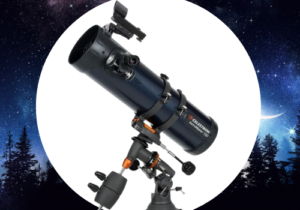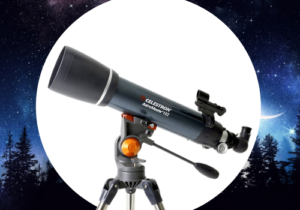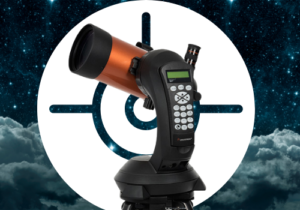Celestron NexStar 127SLT Review: It’s Totally Worth It
Disclosure: This post contains affiliate links and I may earn a small commission (at no extra cost to you) if you click through and make a purchase. Thanks in advance – I really appreciate it!
I was looking for a telescope that was sleek, easy to use, with good aperture size, and a telescope that combined GoTo capabilities with excellent Lunar and planetary viewing.
This is why I purchased my Celestron NexStar 127SLT almost 2 years ago.
This article is an unbiased first-hand review of NexStar 127SLT which will help you decide whether you should buy this telescope or skip it.
In this review, I’ll cover all the best features and the shortcomings of the Nexstar 127SLT, so if you’re seriously considering buying this telescope, then read this article till the end.
My Verdict
If you’re looking for an affordable telescope to view the planets, the moon, and bright deep-sky targets and dabble in short exposure astrophotography, then the NexStar 127 SLT is a great option. The computerized mount is easy to set up and operate while attaching the components (mount, telescope tube, etc) is quite simple. Characterized by a 127mm aperture and sporting Celestron’s proven SkyAlign technology, this telescope offers its users great views of planets and the moon. In addition, the telescope’s single fork arm and simple design make it easy to set up and use. The telescope comes with a few limitations too as some users have reported the mount to be a bit wobbly. It’s also worth mentioning that the GoTo mount eats through batteries, so a more substantial power source is required. So if you are happy to overlook some of the problems, Celestron NexStar 127 might be a good choice.
Pros
- Able to see the planets & the moon in great detail
- Lightweight and portable, great for taking on trips
- Easy to set up and align
- High-quality telescope tube
- Usable for lunar/planetary astrophotography
- 2-Year warranty
Cons
- Mount drains batteries quickly
- Not the best for faint DSOs
- Unstable tripod mount
- Expensive
- COMPUTERIZED STAR LOCATING TELESCOPE: The Celestron NexStar 127SLT offers a database of more than 40,000 stars, galaxies, nebulae, and more. Simply choose an object and the telescope finds it for you in the night sky and tracks it as it moves.
- MAKSUTOV-CASSEGRAIN OPTICAL DESIGN: With a large, 127mm aperture, the NexStar 127SLT can gather enough light to see our Solar System and beyond. View Saturn’s rings, Jupiter’s cloud bands, the Moon's craters, and the Orion Nebula in brilliant detail.
- COMPACT AND PORTABLE: The ideal telescope for adults and kids to use together, the NexStar 127SLT is compact, lightweight, and portable. It's easy to transport just about anywhere—your favorite campsite, a dark sky observing site, or simply the backyard.
- FAST SETUP WITH SKYALIGN: Celestron’s proprietary SkyAlign procedure has you ready to observe in minutes. Center any 3 bright objects in the eyepiece and the NexStar SLT aligns to the night sky, ready to locate thousands of objects.
- BONUS FREE STARRY NIGHT SOFTWARE: Your Celestron NexStar 130SLT includes a free download of Starry Night Special Edition, one of the top-rated astronomy software programs. Simulate the sky, learn about celestial objects, & plan your observing session.
Celestron NexStar 127SLT Review
If you’re looking for an affordable telescope to view the solar system and bright deep-sky targets, then the NexStar 127 SLT is a great option.
At a moderate price and with a decent-sized aperture of 5 inches, this Maksutov-Cassegrain is a worthy contender for those looking to buy their first scope or for those who want to upgrade on their basic telescope.
Maksutov-Cassegrain telescopes such as this one, are far more versatile than reflector or refractor ones.
They are mostly hailed for their excellent near-focus capabilities. Since the optics and light-gathering systems are more advanced than those of a reflector or refracting scope.
Celestron Nexstar 127SLT: Optical Performance
High-Performance Optics
The NexStar 127SLT is a Maksutov-Cassegrain, which provides incredible high-magnification performance. It is delightful for viewing the Solar System. 127SLT’s aperture is 5” or 127mm, its focal length is 1500mm resulting in a focal ratio of f/12. However, according to users of the telescope, the aperture of the lens is a little smaller being roughly 120mm in actual usage.
With this decent aperture size, the telescope will theoretically be able to achieve a max magnification of around 250x whilst the larger focal ratio makes it better for observing planets.
Also, with a 5” aperture, the telescope can easily cover a 0.83-degree field of view.
As far as eyepieces are concerned, each Celestron NexStar 127 SLT telescope comes with a 25mm eyepiece and a 9mm eyepiece, having a maximum magnification of 60x and 167x respectively.
What Can You See With the Celestron NexStar 127SLT?
Although the NexStar 127SLT is a lunar and planetary scope, its f/12.5 focal ratio makes it a little more suitable for deep-sky than some of the competing GoTo Maksutovs.
- The Moon’s surface shows a mesmerizing amount of craters and mountain ranges. Both Lunar photography and observations are superb with this telescope.
- I clearly saw Jupiter’s red spot and even its cloud bands with solid detail near the max magnification.
- You can also see the 4 largest moons of Jupiter.
- You can see Saturn’s rings with the Cassini Division in the middle. Once on a steady night, I even took some decent pictures of Saturn’s moons.
- Mercury and Venus’ phases can be seen. You can also see Venus as a bright yellow disk in the sky.
- I also managed to see Mars’ dark patches and ice caps.
- Uranus, Neptune, and Mercury are hard to observe with any telescope. They look like uninteresting blue tiny dots with Celestron NexStar 127.
Although this telescope is not meant for deep-sky viewing, you can still see some bright DSOs such as Nebulae, star clusters, Andromeda, and a few other bright galaxies.
Views are clear across an excellent proportion of the field of view and as expected with catadioptric telescopes — any color fringing is nowhere to be seen, with the NexStar 127 SLT being of no exception.
If you ask me, as a beginner or even as an intermediate, being able to view this much (with the use of good accessories of course) should satisfy you for quite a while and the alt-azimuth GoTo mount of this telescope should also make the whole process of locking onto planets and celestial objects pretty easy to do.
Let’s quickly take a good look at the NexStar 127SLT’s mount.
The Celestron NexStar 127SLT has been featured in the following articles:
Mount Capabilities
1. Computerized Mount
The NexStar 127SLT comes with a fully computerized altazimuth go-to mounting system, a database that offers over 40,000 objects that it is able to find on its own as well as Celestron’s proprietary SkyAlign software.
The mount used is a GoTo vixen dovetail design which should allow you to move the tube smoothly.
But the 127mm Maksutov optical tube is about at the limit of what the mount can handle. So the OTA is really pushing the mount’s capabilities, this is why some users of this telescope have reported the mount to be wobbly sometimes while viewing.
The mount is battery powered which is a big plus for those who like to travel with their telescope.
But the batteries tend to drain out in 3-4 hours which is a big drawback of this telescope.
I will shed more light on this issue in the “Limitations” section of this article.
2. Hand Controller & Database
The NexStar 127SLT’s hand controller gives its users access to a massive database of 40,000 sky objects.
Although this database includes more than 600 galaxies, 300 clusters, and dozens of beautiful binary stars, a good proportion of these are faint deep-sky objects that the 127SLT’s optical system just isn’t capable of viewing due to its long focal length and small aperture.
But, as I said before, it’s a fantastic telescope to view the planets, the moon, and a few bright DSOs.
All you have to do is just enter the object that you want to view using the hand control, and the telescope will automatically slew and point towards that object.
The NexStar 127SLT is able to do all this because of Celestron’s proprietary SkyAlign technology.
3. SkyAlign Technology
The SkyAlign technology allows the telescope to align itself automatically using common features of the night sky.
This simply means that this telescope can be set up anywhere and you still get the benefits of the database and go-to mount.
The database can also be a great educational tool, especially when paired with the included Starry Night software suite.
Being able to locate, see and learn about thousands of deep space objects can really ignite a passion for some people or be great for a beginner astronomy class for students.
Astrophotography
The lightweight, alt-azimuth SLT mount combined with the 127SLT’s f/12.5 focal ratio means serious astrophotography is just not possible with this telescope.
However, 30-40 second short exposure images are absolutely possible with NexStar 127SLT.
This telescope does a decent job at imaging the Moon and the planets using a lightweight CMOS or CCD camera and a 2x Barlow lens.
But it’s impossible to photograph deep-sky objects such as the Nebulae and galaxies.
Portability
Even when fully set up the 127 SLT is quite portable, weighing in at 18 lbs (8.2 kg), making it ideal for astronomers who like to switch between observing in their garden and traveling to dark-sky sites.
The Maksutov-Cassegrain design of this telescope gives it the sturdiness of a refractor telescope and the light gathering capability of a reflector telescope meaning it can be safely taken along with you without having to worry about damaging it or bumping it out of alignment like some other telescopes.
Thanks to the no-tools technology, the Celestron NexStar 127 SLT can be assembled in less than 10 minutes.
With the help of the included user manual, any newbie can align the telescope without having to consult any videos or tutorials first.
Included Accessories
This telescope kit comes with some great additional accessories in addition to the technology.
Here’s what you are going to find in the box:
- Celestron 127 SLT computerized telescope
- 1 x 25mm eyepiece
- 1 x 9mm eyepiece
- 1 x stainless steel tripod
- The StarPointer Finderscope
- 1 x computerized Altazimuth mount
- 1 x computerized hand controller
- CD-ROM with “The SkyX” Planetarium software
- One free download of the Starry Night software.
- 2-year warranty certificate.
The star diagonal provides a right-side-up view and a more comfortable viewing angle when looking up at the sky.
The StarPointer red dot finderscope will help you quickly center an object in your eyepiece for easier observing.
The Starry Night software is a great all-around software package for aspiring and advanced astronomers alike as it will teach you about celestial objects.
Limitations
Although the NexStar 127SLT is an amazing GoTo telescope for beginners and intermediates, it comes with a few limitations of its own.
What I found most annoying was that the telescope doesn’t come with a power source.
It comes with a slot for 8 AA batteries. But, they run out in 3-4 hours, which is obviously, inconvenient and can be expensive.
So I highly recommend buying a dedicated DC power supply or external battery packs (Amazon link open in new tab).
You may also power your telescope with a 12V AC adapter (Amazon link opens in new tab).
Although the views from this telescope are generally considered excellent for such a small entry-level scope, the downside to the 127SLT is a tendency for the mount to suffer from vibrations, which is not actually a deal-breaker but rather annoying.
As I have mentioned before, although this telescope is capable of giving you magnificent views of the moon and the planets, it’s only good for bright DSOs and rather disappointing when it comes to the fainter Nebulae and galaxies.
Conclusion
The Nexstar 127SLT telescope from Celestron is a perfect telescope for beginners and intermediate users to ease them into the world of astronomy. Characterized by simple design, no-tool setup and Celestron’s propriety Sky align technology this telescope gives users a great planetary and lunar view without any inconvenience.
Written by:

Jason Parnell
At 15, I sold my bike to buy my first telescope. I spent the next 3 years sketching as many Messier objects as I could find from my garden, then at the age of 18, I discovered beer. I have wandered through California's Mojave Desert with other amateur astronomers in search of the best stargazing experience.
ABOUT US
We are a team of active amateur astronomers, here to help you with all your astronomy and science related needs – this is anything, from reviewing the latest telescopes to be released to talking about gravity and neurons. The Big Bang Optics was started because of our love for astronomy and to help others like us find the best telescope and accessories.
LEGAL DISCLAIMER
The Big Bang Optics is a participant in the Amazon Services LLC Associates Program, an affiliate advertising program designed to provide a means for sites to earn advertising fees by advertising and linking to Amazon.com. The Big Bang Optics also participates in affiliate programs with Clickbank and other sites. The Big Bang Optics is compensated for referring traffic and business to these companies.





